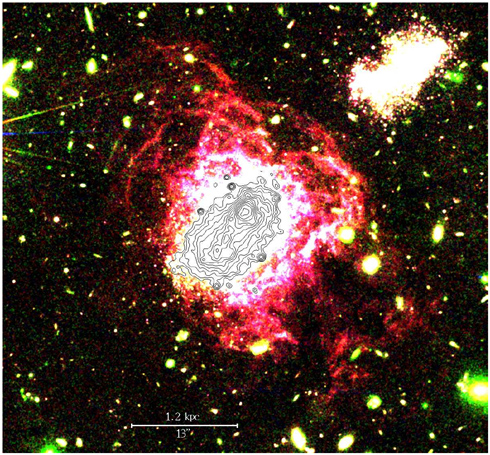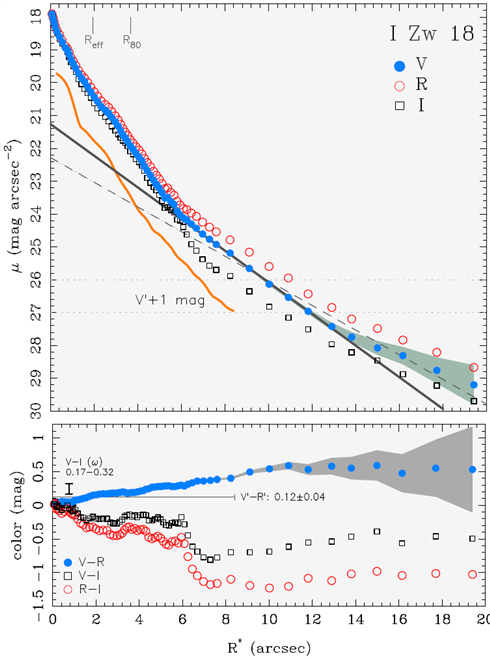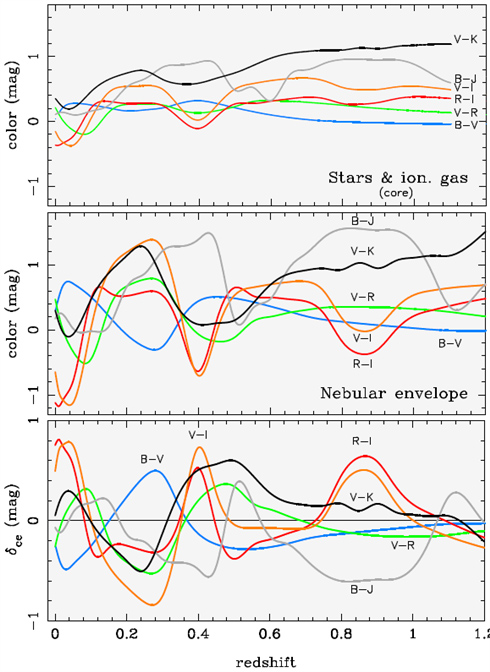I Zw 18 as morphological paradigm for rapidly assembling high-z galaxies,
Astronomy and Astrophysics, Volume 537, pp. A126 (2012)
I Zw 18, ever since regarded as the prototypical blue compact dwarf (BCD) galaxy, is, quite ironically, the most atypical BCD known. This is because its large low-surface brightness (LSB) envelope is not due to an old underlying stellar host, as invariably is the case for typical BCDs, but entirely due to extended nebular emission[1]. Our goal is to explore I Zw 18 and its detached C component I Zw 18 C down to an unprecedently faint surface brightness µ (mag/⃞'') level in order to gain further insight into the structural properties and evolutionary history of this enigmatic galaxy pair. We present a photometric analysis of the entire set of archival HST ACS V, R and I band data for I Zw 18. Radial color profiles for I Zw 18 C reveal blue and practically constant colors (0±0.05) down to µ~27.6, and a previously undisclosed, slightly redder (V–I≈.2), stellar population in its extreme periphery (µ ~29). We argue that stellar diffusion over τ~108 yr and the associated stellar mass filtering effect[1] can consistently account for the observed properties of the stellar component in the outskirts of I Zw 18 C. This process, in combination with propagating star formation with a mean velocity of ~20 km s-1 can reproduce all essential characteristics of I Zw 18 C within ~ τ. An extremely faint substrate of older stars can neither be ruled out nor does need be postulated. As for I Zw 18, we find that nebular emission (ne) extends out to ~16 stellar scale lengths, shows a nearly exponential outer profile, and provides at least 1/3 of the total optical emission. ne dominates already at µ ~23.5, as evident from e.g. the uniform and extremely blue (V–I≈1, R–I≈1.4) colors of the LSB envelope of I Zw 18. The case of I Zw 18 suggests caution in studies of distant galaxies in dominant stages of their evolution, rapidly assembling their stellar mass at high specific star formation rates (SSFRs). It calls attention to the fact that ne is not necessarily cospatial with the underlying ionizing and non-ionizing stellar background, neither has to scale with its surface density. The prodigious energetic output during dominant phases of galaxy evolution may result in large exponential ne envelopes, extending much beyond the still compact stellar component, just like in I Zw 18. Therefore, the morphological paradigm of I Zw 18, while probably unique in the nearby Universe, may be ubiquitous among high-SSFR galaxies at high redshift. Using I Zw 18 as reference, we show that extended ne may introduce substantial observational biases and affect several of the commonly studied fundamental galaxy relations. Among others, we show that the surface brightness profiles of distant morphological analogs to I Zw 18 may be barely distinguishable from Sérsic profiles with an exponent ~2 < η < ~5, thus mimicking the profiles of massive galaxy spheroids.

Figure 1 | Composite image of I Zw 18 and I Zw 18 C with the R, I and V bands shown in the red, green and blue channel, respectively. The image discloses a complex network of ionized gas filaments extending as far out as 2.6 kpc, approximately twice the distance reported from previous HST WFPC2 studies, corresponding to ~16 exponential scale lengths a of the stellar host galaxy of I Zw 18 (160 pc[1]). The contours[1] are computed from HST WFPC2 R data, after two-dimensional subtraction of the Hα emission (referred to as R'), they thus delineate the morphology of the stellar and nebular continuum emission in the main body of I Zw 18. Contours go from 19 to 25 R' in steps of 0.5 mag. Note that I Zw 18 (i.e. its stellar component, as depicted by the R' contours) and I Zw 18 C show a remarkably similar structure.
I Zw 18, classified as a blue compact dwarf, is a unique galaxy since it is the third most metal-poor star-forming galaxy known in the universe and its low surface brightness envelope is due only to nebular emission. This galaxy has two star-forming regions – the northwestern (NW) and the southeastern (SE) components – and, through spectroscopy, several features have been previously identified and nicknamed (e.g., the “loop”, “Hα arc” and “ω”). Previous studies of this object showed that both star-forming regions are embedded within an extended, low-surface brightness envelope and that strong nebular emission can be found throughout the galaxy (Fig. 1). The most recent measurements place I Zw 18 at a distance of about 19 Mpc.
Over the time since its discovery, astronomers held several different views about the evolutionary status of I Zw 18. For instance, some consider it to be a true young galaxy, currently forming its first generation of stars, while others believe I Zw 18 is an old galaxy, which has been forming stars over the Hubble time. In spite of all the observational data currently available, this is still a matter of debate but is has already been firmly established that, at least, there isn’t a significant stellar component in the low-surface brightness envelope[1], what contrasts to all other blue compact dwarfs known to date.
However, Hubble Space Telescope has, over the past few years, amassed a large amount of V, R and I broad band data of I Zw 18, which was now used to study this galaxy and, in particular, its nebular emission, through deep surface photometry, up to µ ~ 29 mag/⃞''.
The analysis of the data showed that the extended halo is completely deprived of stars and that its nebular emission accounts for about ~30-50% of the total visible emission of I Zw 18. Furthermore, the researchers also concluded that the luminosity profiles of similar galaxies, along with the exponential profile presented by the nebular emission halo (Fig. 2) can mimic the profiles of massive elliptical galaxies. All these facts have strong implications for our current knowledge of extragalactic astronomy and observational cosmology.

Figure 2 | (upper panel) V, R and I surface brightness profiles (SBPs) of I Zw 18. The thick-solid and thin-dashed lines show linear fits to the V SBP in the radius range 7''≤R*≤15'' and R*≥7'', respectively. The effective radius Reff and the radius R80 enclosing 80% of the total V emission are indicated. The V SBP derived[1] after subtraction of the Hß and [OIII] λ4959,5007 emission lines (referred to as V'), shifted by +1 mag for the sake of clarity, is included for comparison. (lower panel) V–R (filled circles), V–I (squares) and R–I (open circles) color profiles, computed from the SBPs in the upper panel. The vertical bar indicates the V–I color range inferred[1] from ground based and HST PC data for region ω at the southeastern tip of I Zw 18 (V–I(ω) = 0.17 . . . 0.32 mag). Since nebular emission is relatively weak in that region, its color can be considered representative for the stellar host of I Zw 18. The mean V–R color of I Zw 18’s host after subtraction of nebular line emission (V'–R'=0.12±0.04 mag[1]) is indicated by the horizontal line. Note that the colors V–R(ω) and V'–R' of the stellar host galaxy are by, respectively, ≳ 0.8 mag redder and ≈0.4 mag bluer than the colors of the exponential nebular envelope (R*≥6'').
First of all, studies of distant galaxies have been assuming that nebular emission accounts for just a few percent of the total emission in galaxies and it is, therefore, negligible, which is not the case for I Zw 18. Since starburst galaxies, like this one, are expected to be quite abundant in the early universe, astronomers may have been overestimating the stellar emission, which also implies an overestimation of stellar mass, since it is typically done assuming a given relation between mass and luminosity. In turn, the overestimation of protogalaxies’ mass, by comparison with the masses we observe in local galaxies, may change our interpretation of how the galaxies assembled their masses over the lifetime of the universe.
Furthermore, the nebular emission spectrum has a different shape from that of stellar emission and, therefore, it also presents a different variation with redshift (Fig 3). Thus, comparision of visual luminosity of galaxies at different redshifts, usually done resorting to k-correction factors, may be biased in an almost unpredictable way.

Figure 3 | Variation of the observed color as a function of redshift z for a template galaxy with the properties of I Zw 18. The model consists of a high-surface brightness core to within which stellar emission is confined and dominates (upper panel), and a larger lower-surface brightness nebular envelope (middle panel). The colors of the core and the envelope yield for z = 0 a good match to the observed values for the core (R*≤6'') and the nebular envelope (6''≤R*≲ 20'') of I Zw 18. The lower panel shows the dependence of the color contrast δce between the core and the envelope as a function of redshift.
The case of misclassification of galaxies may also lead to an incorrect view of the galaxies evolution. By classifying small diskless protogalaxies as either disk galaxies or massive elipticals, we may be placing more evolved galaxies closer to the Big Bang than they actually are.
Thus, when studying the evolution of galaxies and their mass assembly history, all these effects must be carefully taken into account, as shown by this work.
Another point of interest for I Zw 18 is that the new data also proves the fact that most of its stars are extremely young, with less than 1 Gyr. This, together with its very low metallicity, makes it an excellent, local laboratory for studying dwarf galaxy formation.
The CAUP researcher has contributed the essential part of the discussion and the data analysis and interpretation.

